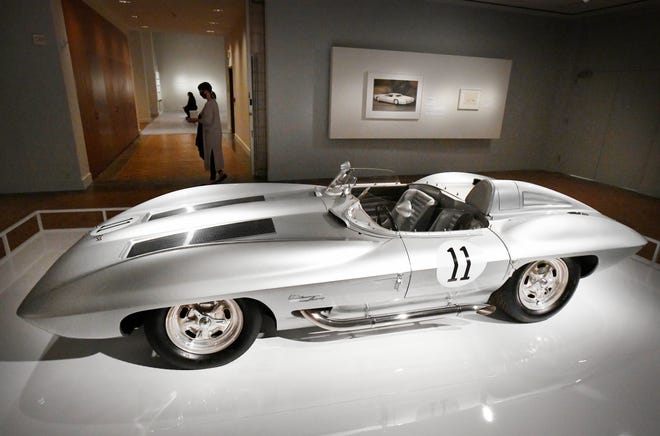Sexy 'Detroit Style' revs up DIA
 Michael H. Hodges
Michael H. HodgesFor anyone of a certain age, the first couple galleries in "Detroit Style: Car Design in the Motor City, 1950-2020," opening Sunday at the Detroit Institute of Arts, are likely to make you teary with romantic nostalgia.
It's hard to behold the white 1957 Chrysler 300C that greets you on entering, a gleaming essay in lavish chrome and excess, without gasping. Shined and buffed to within an inch of its life, like all 12 cars in this absorbing show, the vehicle radiates sexiness and unbridled ambition.
Which in many ways was precisely the point, since one of the cardinal lessons this breezy, entertaining exhibition imparts is that cars are designed -- perhaps more than any other products -- to stir our deepest longings and desires.

"It's remarkable the power these machines have," said DIA Associate Curator for American Art Benjamin W. Colman, who oversaw the show and produced the handsome catalog that accompanies it. "They inspire stories that are so personal and meaningful."
We live among zillions of designed objects, he added, but few have the emotional pull of the automobile.
The exhibition's galleries, happily not over-jammed with things to look at, are organized by decade. Vehicles all come from the Big Three, and range from experimental show cars to mass-market creations, from the hyper-futuristic 1958 Firebird III prototype, about as Flash Gordon as you could want, to Harley Earl's utterly voluptuous 1951 General Motors Le Sabre.
Indeed, Life Magazine declared -- nine years ahead of time -- that the "'Sabre' is the Car of the 1960s."
But, many will ask, is there a classic Corvette on display?

Of course there is, a 1959 silver Stingray Racer. There's also a fierce black 1967 Mustang and a 1970 Chrysler/Plymouth Barracuda, red enough to knock your socks off, and designed with "boldly angular features emphasizing brute mechanical force," as the show's catalog notes.
Colman cautioned, however, "We don’t consider this to be the '12 Greatest Hits of Detroit Designs.' Rather, we're trying to tell a focused story about design ideas and how those change and adapt to differing challenges over time."
One of the show's virtues is that it takes the visitor through the entire design process, from earliest sketches -- many of which are framed on the walls -- to sculpting a life-sized model in reddish-brown clay. It also highlights several key designers whom history has largely forgotten.
Said Colman, "As someone who came to this project with a background in design history, what was most surprising was that these incredibly influential Detroit designers, apart from Harley Earl, have not received their due in the history of modernism in the United States."

By example, he cited Virgil Exner – "Earl’s counterpart at Chrysler in the 1950s" – who created the "forward look" that characterized the 300C and other Chrysler products into the early 1960s.
Exner, Colman noted, isn't well known, "even though he was often featured in the press, and his work was closely followed. But it’s just not the history that’s been told as fully as that of Florence Knoll or Charles and Ray Eames, the bold-faced names in modern design."

The founder of GM's Design Archive and Special Collections, Susan Skarsgard, was on an early advisory committee for "Detroit Style." She tips her hat to both Colman and DIA Director Salvador Salort-Pons for mounting the exhibition in the first place.
"The DIA should be commended for taking on an industry with this hugely important aesthetic component that’s so integral to our society in Detroit," Skarsgard said, "and so influential in the American design community."
If you go to "Detroit Style" -- and note you have to reserve a specific time and day; you can't just walk in -- do sit and watch the two short videos, crisp essays in which designers talk about their work, most filmed, appropriately, in front of Diego Rivera's "Detroit Industry."
It's seems to be a moment for autos and museums. Last year, the Toledo Museum of Art organized "Life Is a Highway: Art and American Car Culture," while in London the Victoria & Albert just closed "Cars: Accelerating the Modern World" in April.

Given the American romance with the car, it's hard not to think "Detroit Style" would do well if it traveled around the country. Alas, that's not in the cards.
"It won’t travel," Colman said. "It’s such a love letter to Detroit, and the story we’re telling is so local and focused," he added, "it's likely to be more meaningful to people from the Detroit area than it could be elsewhere."
mhodges@detroitnews.com
(313) 815-6410
Twitter: @mhodgesartguy
'Detroit Style: Car Design in the Motor City, 1950-2020'
Sunday - June 27
Detroit Institute of Arts, 5200 Woodward, Detroit
Reservations are required:
Visit ticketapp.dia.org or call to pick a day or time
$14 - adults, $9 - seniors, $8 - students with ID, $6 - kids 6-17; Wayne, Oakland & Macomb residents enter free
9 a.m.- 4 p.m. Wed.-Fri; 10 a.m.-5 p.m. Sat.-Sun.
(313) 833-7900